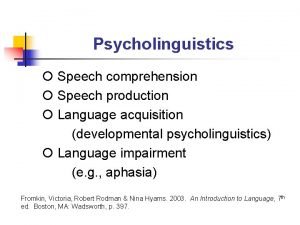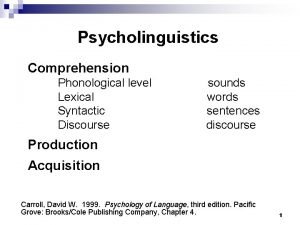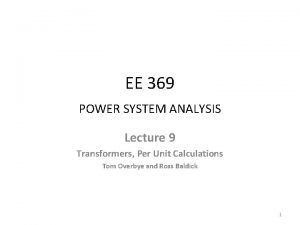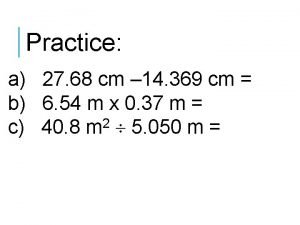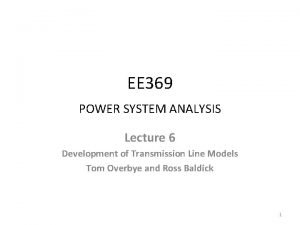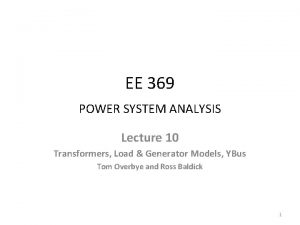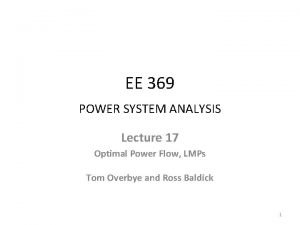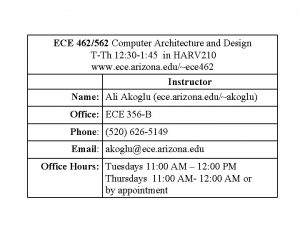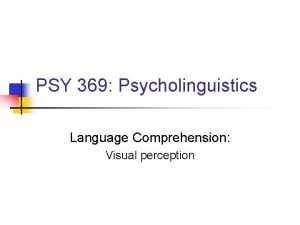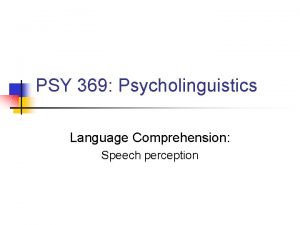PSY 369 Psycholinguistics Language Comprehension Introduction Perception of



























- Slides: 27

PSY 369: Psycholinguistics Language Comprehension: Introduction & Perception of language

Some of the big questions Production “the horse raced past the barn” How do we turn our thoughts into a spoken or written output?

Some of the big questions Production Comprehension “the horse raced past the barn” How do we turn our thoughts into a spoken or written output? How do we understand language that we hear/see?

Overview of comprehension Input The cat chased the rat. Language perception c a t /k/ /ae/ /t/ Word recognition cat dog cap wolf tree yarn cat claw fur hat Syntactic Semantic & pragmatic analysis S NP VP the cat V NP chased the rat

The Comprehender’s Problem n Must take a potentially ambiguous serial acoustic (or visual) input, and recover the intended meaning The cat chased the rat.

The Comprehender’s Problem n Must take a potentially ambiguous serial acoustic (or visual) input, and recover the intended meaning Oronyms I scream for ice scream The stuffy nose can lead to problems. The stuff he knows can lead to problems. Why don’t you take a nice cold shower? Why don’t you take an ice cold shower? See here for more oronyms

The Comprehender’s Problem n Must take a potentially ambiguous serial acoustic (or visual) input, and recover the intended meaning Groucho Marx shot an elephant in his pajamas Good shot How he got into my pajamas I’ll never know

The Comprehender’s Problem n Must take a potentially ambiguous serial acoustic (or visual) input, and recover the intended meaning “Oh no, Lois has been hypnotized and is jumping off the bank!” Money “bank” River “bank”

Different signals If reading were like listening whereareyougoing

Different signals Visual word recognition n n Some parallel input Orthography n n n Letters Clear delineation Difficult to learn Speech Perception n n Serial input Phonetics/Phonology n n n Acoustic features Usually no delineation “Easy” to learn

Different signals Visual word recognition Where are you going

Different signals Speech Perception

Articulatory features n Point of articulation n Six major points: n n Manner n n Larynx, soft palate, tongue body, tongue tip, tongue root, lips How the articulator moves: nasality, aspiration, etc. Configuration of other organs n Voiced, rounded, etc. see mixed features hear those features

Phonemes: articulatory features full chart Symbols and sounds

Speech perception n Articulatory phonetics n Production based n n Place and manner of articulation Acoustic phonetics n Based on the acoustic signal n Formants, transitions, coarticulation, etc.

Speech production to perception n Acoustic cues are extracted and stored in sensory memory and then mapped onto linguistic information n Air is pushed into the larynx across the vocal cords and into the mouth nose, different types of sounds are produced. n n The different qualities of the sounds are represented in formants The formants are mapped onto phonemes

Acoustic features n Spectrogram n n n Time on the x-axis Frequency (pressure under which the air is pushed) on the y-axis Amplitude is represented by the darkness of the lines

Acoustic features n Formants - bands of resonant frequencies n n Formant transitions - up or down movement of formants Steady states - flat formant patterns Bursts - sudden release of air Voice onset time (VOT) - when the voicing begins relative to the onset of the phoneme

Formants in a wide-band spectrogram Burst --> <-- Formant transitions -------> <-- F 1 <-- F 3 <-- F 2

Voice-Onset Time (VOT) bit 5 ms pit 40 ms

What looks similar to the eye will probably seem similar to the ear! [ b. A The confusion of palatalized labials > dentals & alveolars

Problem: Co-articulation n n Co-articulation, the influence of the articulation (pronunciation) of one phoneme on that of another phoneme. http: //cnx. rice. edu/content/m 11175/latest/

Problem: Co-articulation Wave form n Linearity n n Acoustic features often spread themselves out over other sounds n Where does show start and money end? Invariance n One phoneme should have a one waveform, but: n The /i/ (‘ee’) in ‘money’ and ‘me’ are different

Categorical Perception 1. Set up a continuum of sounds between two categories /ba/ 1 - . . . 3 … /da/ 5 … 7

Categorical Perception 2. Run an identification experiment 100 Sharp phoneme boundary % /ba/ 0 1 . . . 3 … 5 … 7

Trading relations • Most phonetic distinctions have more than one acoustic cue as a result of the particular articulatory gesture that gives the distinction. • Perception must establish some "trade-off" between the different cues. Can this trade-off be explained by low-level auditory processes such as short-term adaptation, or do they require processes specific to speech? • Repp (1982) Psych Bull. 92, 81 -110

n Mc. Gurk effect
 Garden path sentence
Garden path sentence Cohort model psycholinguistics
Cohort model psycholinguistics Comprehension of words in psycholinguistics
Comprehension of words in psycholinguistics Language loss in psycholinguistics
Language loss in psycholinguistics Short division vs long division
Short division vs long division Cs 369
Cs 369 369
369 Ge power management
Ge power management Norm bartley
Norm bartley 369 meaning
369 meaning 369 power
369 power Bio 369
Bio 369 369 project
369 project 369 project
369 project 369 power
369 power Datapy.bar
Datapy.bar 369 power
369 power Ece 369
Ece 369 Euro psy
Euro psy Psychology ucf
Psychology ucf Psy2055
Psy2055 Psy 2055
Psy 2055 Psy 2055
Psy 2055 Psy
Psy Psy sanin
Psy sanin Psy
Psy Psy
Psy Phonological loop
Phonological loop
